Welcome to Hank’s January 2025 Astrophotography Blog. The big news this month was that 7 planets were stretched along the ecliptic of the night sky. If you were lucky and looked early in the month, you could see Saturn. It was close to the sun as it was setting in the west. You can still see Mars, Jupiter and Venus in the sky at night, but the others (Mercury, Uranus and Neptune) you can’t see unless you are looking through a telescope. The planets are spread across the sky, so it is difficult to capture it with a single photograph, so I took a series of images to catch the three planets that will be visible for a few more nights. While I was at it, I labeled the other bright stars in the southern and western skies:
–Betelgeuse and Rigel are the top and bottom stars of the Orion Nebula, where between them you can see the belt and sword sheath of the hunter.
–Behind and below Orion is his Big Dog (Canis Major) with Sirius being the prominent star there.
–Above the big dog is the small dog constellation (Canis Minor) with Procyon being the bright star in that constellation.
–Above Procyon are Pollux and Castor, the Gemini twins, with Mars sailing through that constellation.
–Just below the planet Jupiter are 5 stars in a triangle that make up the horns of Taurus the bull. The (more than) 7-star cluster Pleiades is also in the constellation of Taurus.
–Venus, our brightest planet and always close to the horizon as it is between the Earth and the Sun, is about to disappear into the West.
The planets will move through these constellations, but the stars that make them up will stay pretty much in their same positions for our lifetime. Over thousands and millions of years, however, the stars in our constellations will change the way they align themselves, and the way they appear to those who live on Earth.
NGC 2264 is a large nebula in Monoceros, with two major sections called the Cone Nebula and the Christmas Tree Cluster. Shown here is a lesser-known part, called the Fox Fur Nebula.
I’ve taken photos of M51 many times, and I just can’t resist taking a photo of these two galaxies, sharing their stellar matter. Ohhhhhh.
The way I have my telescope set up now, I can’t get the full field of view to see all of the big stars in Plieades, but I could capture two. M45. I love the blue emissions.
M 108, the Surfboard Galaxy, is a pretty cool galaxy. For something 46 million light years from Earth and turned on its side, it shows quite a bit of detail. I’m not sure if this was the surfboard that the Silver Surfer rode to town on, but it might be a good candidate.
Until next time, Clear Skies! -Hank




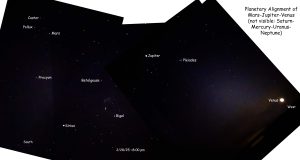
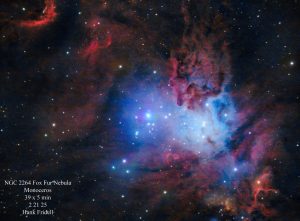
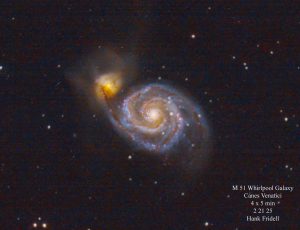
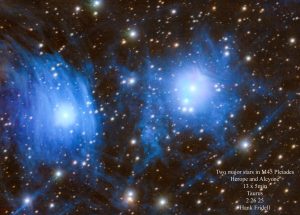
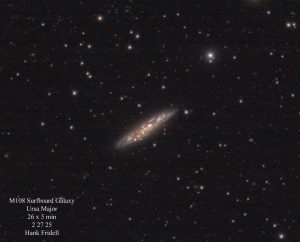
Helped me view the planets that are aligned and visible. Thanks Hank
Mike-Thank’s for the note! At least something in our lives align the way they are suppose to! -Hank
I love it! The M45 & the M 108 are so cool. the 45 looks like 2 blue eyes! If you’ve ever seen the movie the Transformers they look just like Optimus Primes eyes! Thank as always for “enlightening” our lives!
Your favorite niece………Kim
My favorite niece–Thanks for the note! I guess I’ll have to check out the Transformer movies…….
Your favorite uncle
Hank, nice work – but my pedantic nature has been aroused. The Latin for dog is Canis not Ursa. In Latin, Ursa means bear. Polaris is in Ursa Minor (Little Bear), Sirius is Alpha Canis Major, and Procyon is Alpha Canis Minor.
George–Thanks for catching that! I’ve corrected the error. I let the BHAS membership know when I’ve posted my blog so they can help keep me honest…and factual! I know that I can count on you! -Hank